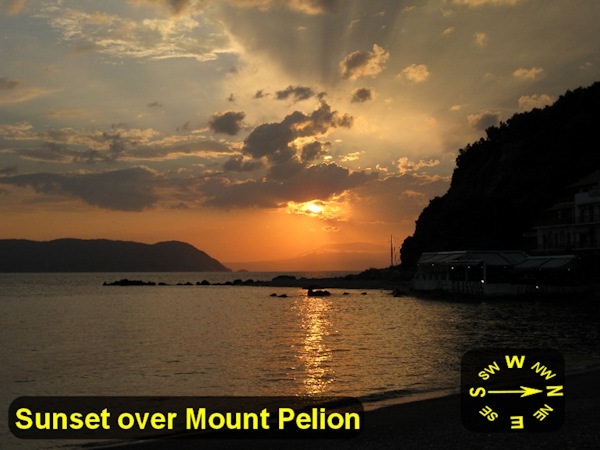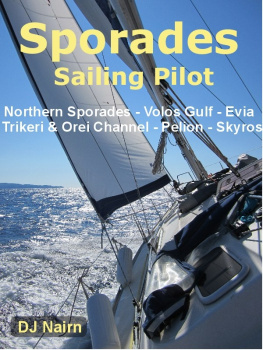COPYRIGHT NOTICE
Dave Nairn 2012
All rights reserved. No part of this publication may be reproduced, stored in an information retrieval system, electronic or otherwise, or transmitted in any form or by any means including: electronic, mechanical, graphical, copying, photocopying, recording, taping, scanning or otherwise, except under the terms of the Copyright, Designs and Patents Act 1988, without the permission in writing of the author or publisher.
The sketch maps drawn by the author are meant to illustrate and explain the text and should not be used for navigation. While every effort has been made to ensure the text and sketch maps are accurate the author and publisher assume no liability or responsibility arising out of any errors made in this book. To report any errors or suggest content improvement please email: delphinuspublishing@gmail.com
Sailing in Sporades

The Northern Sporades, Gulf of Volos and surrounding seas provide sailors with an exceptional cruising area. The islands and areas in theGulf of Volos have their own unique character, having escaped the detrimental effects of large scale tourism. The formation of the NationalPark should help to preserve the environment which is important to the abundance of wildlife and some endangered species. The weather is dominated by meltemi winds which providesexhilarating sailing between the islands and fast flat water conditions on their leeward side and in the Gulf of Volos. The facilities for yachts are not aswell developed as in other cruising areas but adds to the charm of the Northern Sporades, making this area a joy to sail. The Sporades island group sits astridethe traditional sea-trade route between the Black Sea and the Mediterranean but the history of the area is more than just peaceful commerce as their geographicposition placed the islands in the cockpit of relentless bloody conflicts down through the centuries.
Their Aegean location was slap-bang in the firing line for any naval incursions heading for the Greek Mainland and even if an invading force, such as thePersians, advanced down the mainland coastal plain then their left-wing was invariably protected by a strong fleet sailing just offshore. As island settlementsprospered and grew they became more attractive for plundering and inhabitants were forced to build fortifications, usually on hilltops or surrounded by cliffs,and often hidden from seaward.
In olden times sailors tended to hug the coast and the narrow channel between Skiathos and the Pelion Peninsula on the mainland coast of Magnesia, with theIsland of Evia just to the south, created a natural choke-point for shipping whether intent on peaceful commerce or war.
The area was a very important link in the complex chain of constantly manned signalling towers constructed by the Greeks to speedily pass important militarymessages across water and trackless terrain. Aeschylus, the Athenian tragic poet, described in his Agamemnon how news of the Fall of Troy in 1184BC wastransmitted 600 km in a few hours by fire signals from the battle site to the city of Argos in the Peloponnese viaMakistos (Vigil Candle) Mountain on Evia.
SKIATHOS ISLAND

The Isle of Skiathos is a green and verdant spot in the Aegean and attractive from seaward. Some say the island got its name from skia meaning shadeor shadow in Greek and like some other Sporades islands is covered in vegetation. Others claim a more romantic meaning behind the name and say its acombination of skia and athos and came about because the shadow of Mount Athos created by the sun on Midsummers Day kissed andthus blessed the Isle of Skiathos. The 6,600 ft high Mount Athos, on the Halkidi Peninsula, has housed a monastic community since the 3rd century and isknown as the Holy Mountain Only problem is that Mount Athos being north of Skiathos could never cast a shadow on Skiathos although Mount Pelion mightat sunset.

Katigiorgis is just 2.5 NM away on the Mainland across the Skiathos Channel and to the north the Halkidi Peninsula has helped bar the traditional sea routefor invaders bent of sujugating Greece. Persian King Darius saw 300 of his ships wrecked wrecked on Halkidis rocky tip by a storm in 492BC and Spartahad 50 ships share the same fate in 411BC.
Skiathos is famous for its beaches and has more than 60, many only accessible by boat and despite being a busy tourist destination the island still holdsa unique charm for visitors who are repeatedly drawn-back. The island has its own international airport with daily flights to Athens and charter services from many European airports in the summer. Indeed, growingtourism has led to plans being announced at the end of 2011 to increase the size of the airport which will lead to Xanemos Beach being built over. Ferry servicesrun from the island to Ag Konstantinos on Evia and the City of Volos.
A single main road runs along the south coast from Skiathos Town to Koukounaries served by regular bus services which makes it very simple to leave youryacht and explore some of the many beaches dotting the islands coastline. The buses can get very crowded in the main holiday season but bike, scooterand vehicle hire outlets are plentiful. Skiathos Town has everything you would expect and need from this size of community and with good night-life, excellentrestaurants, shops and boutiques.
It hasnt always been the main settlement on the island with people shifting backwards and forwards from The Kastro the fortifiedcliff-top position on the north coast built in the 14th Century as a refuge from pirate attack. Skiathos is a small island about 5.9 x 4.5 nauticalmiles (nm) with a 21nm coastline so there wasn't a lot of places to hide from invaders. Nowadays the sheltered south contains the majority of the populationwith the remote northern coastline remaining rugged bearing the brunt of the prevailing NE meltemi winds.
The islands maritime history stretches back to ancient times with a 4th century BC mention as an ideal anchorage for overwintering naval ships and local people rightly maintain pride in their seafaring and maritime heritage. The Barbarossa Brothers were probably the most infamous pirates but Skiathos suffered numerous corsair incursions with a long history of relentless subjugation and constant attack from external forces including the Persian, Roman, Byzantine, Venetian and Ottoman Empires.
Skiathos is studded with churches and monasteries Evangelistria is the most visited through its special significance as a centre of resistanceduring the long and often bloody Greek independence struggle when Skiathites were sustained by their deep-seated faith in the Greek Orthodox religion.There are almost 400 island churches, monasteries and convents with many sited in Skiathos Town. St Nicholas has two island churches dedicated to him andbecame patron saint of Seafarers & Sail through his voyages to the Holy Land.
ISLE OF SKIATHOS

1) SOUTHERLY APPROACHES TO SKIATHOS

When making a southerly or easterly approach to Skiathos Harbour the islands dotted around the bay are easily identified. The most common approach,and easiest at night, is from the south and follows the local airport flight path. Sailing north you leave Nisos Tsoungriaki to starboard and KalamakiPeninsula to port before encountering Daskalonissi the rocky islet at the entrance to Skiathos Bay. From the east, the main channel can be found leaving Repi,Arko and Marangos Islands to the north and Tsoungria Island to the south, then turning north when clear of Marangos Island.






![Greek islands [2018]](/uploads/posts/book/209249/thumbs/greek-islands-2018.jpg)







